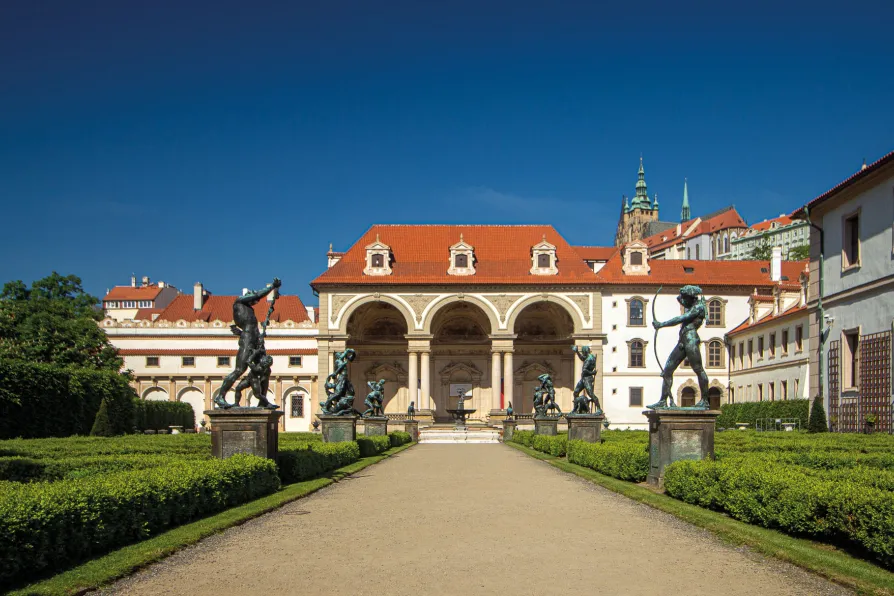Trump’s escalation against Venezuela is about more than oil, it is about regaining control over the ‘natural’ zone of influence of the United States at a moment where its hegemony is slipping, argues VIJAY PRASHAD
Error message
An error occurred while searching, try again later.The famously beautiful palace in Prague was named after the brutal Czech warlord Wallenstein, commander of the Thirty Years’ War, as was a Czech SS division in WWII — and so too was a regiment after the counter-revolution of 1989 … JOHN CALLOW traces the threads of history…

 EVOCATIVE: The Wallenstein Palace, which is now home of the Czech senate. Photo: Vitvit/Creative Commons
EVOCATIVE: The Wallenstein Palace, which is now home of the Czech senate. Photo: Vitvit/Creative Commons
THE Wallenstein Palace, in the bustling tourist hub of Prague’s “lesser town,” possesses a strikingly savage beauty. White and crowned peacocks bask in the sunlight and slip across the colonnades calling to their mates. The fountains play, while across the road the students of an American school crowd a courtyard for their morning lecture.
As befits the home of the Czech senate, since 1993, the flags of the republic and the European Union flap, in synchronicity, from staffs lifted high above the arbours, bright roof tops, and formal gardens. However, look closer and one can detect — even at the distance of 400 years — an underlying sense of violence and horror.
The classical statues depict scenes of battle, rape, and strife: a rearing horse pounds down upon a snake; Hercules smirks as he shoulders his club and brandishes the flayed carcass of the Nemean lion; even Poseidon grimaces, thrusting forward a naked pelvis, while a hunting dog slavers and snarls at his feet.
Newly and lovingly restored, the frescoes adorning the porticoes portray the fall of Troy and the slaughter and enslavement of its civilian inhabitants. Inside, the halls, repurposed for the use of today’s politicians, frescoes show the palace’s saturnine creator — Albrecht von Wallenstein — as both the Mars and Vulcan of war, crushing his enemies beneath the wheels of his chariot.
Wallenstein was the supreme warlord produced by the Thirty Years’ War; an accomplished battlefield commander, logistician and military financier, whose private fortune and personal power rivalled, and threatened to eclipse, that of the Holy Roman Emperor whom he nominally served.
As a young man, he stabbed a fellow student through the thigh, in a fit of anger and almost beat to death a servant whom he accused of laziness. As a mercenary captain, he was quick to abjure both the religion and the country of his birth; sequestrating Protestant estates and the very land that his palace was built upon after the Battle of the White Mountain.
He would usher in the Baroque splendour of Counter-Reformation Prague through massacres and the curtailment of religious freedom. At the zenith of his power, his melancholy revealed itself through his reliance upon the predictions of astrologers (most notably Kepler), and while he ordered complete silence within the confines of his luxurious halls, he chose to appear, suddenly, at the side of petitioners and courtiers having made use of the hidden walkways that honeycombed the cascading grotto in his gardens. It is little wonder that Schiller chose to make him the central character in one of his brooding, Gothic tragedies.
That his image is now placed at the heart of the Czech Republic’s assembly is not without significance. The histories of Hus, Comenius and Palacky have had to be replaced with a different narrative; something coarser, that speaks of martial power, financial gain, foreign domination, and the triumph of might over reason. A Czech SS division was named after Wallenstein and the resettling of that name, by Vaclav Havel after the counter-revolution of 1989, upon a regiment was calculated to send a signal that the nation was rejecting one vision of the past and rehabilitating another.
That rehabilitation is much in evidence, across town. Outside the Pavlova metro station, the hard right are distributing bags of candied sweets, alongside their election broadsheets, to peak-time commuters. Svelte young women in crop tops and polished young men in chinos and US marine corps tops have been hired-in for the job from the university “conservative clubs,” private schools and academies.
The message of the Motoriste (literally the Motorists’) Party is uncompromisingly anti-progressive, anti-green and anti-communist. Their posters mock the unassuming, and always measured, Katerina Konecna, (the leader of the left-wing “Stacilo!” — Enough! — coalition) as a Stalinist stooge, photoshopping Soviet stars over her eyes.
They evoke the spectre of intolerance and state violence stalking the left, yet flirt with Nazi symbolism, brandish SS daggers and ape Hitlerite salutes. Their policies are a hodgepodge of reaction: lower taxation for the rich, an aggressive free market predicated upon welfare cuts, the banning of cycle lanes, and the breathless exaltation of gas-guzzling limousines.
It’s a curious mix of populist and elite concerns but one which seems to have resonated with the middle-aged skinhead who sits, alone, on the platform of the little branch line that links Prague with the tourist centre of Karlstejn. Well dressed, and fine featured, his knuckles anxiously flick over the handle of his brief case and the red shard of paper that he has just torn from a “Stacilo!” election poster.
Here, too, the hard right have been at work. Most of the images of Katerina Konecna have been defaced with ugly messages and even uglier symbols, denoting a sexualised violence alongside the gutter fare of anti-communist rhetoric. Our skinhead stirs, revealing the date “1989” tattooed onto his throat.
For him, the date signifies a watershed moment in Czech history when things long forbidden were once again permitted and promoted. It has become acceptable to refashion the past, to bring the tramp of jackboots and the shadow of Wallenstein from out of the shadows, to fetishise greed and to despise reason, collective action, and principle.
As a consequence, the Czech elections, held yesterday and today, are of enormous importance in determining the fate of the nation and in ensuring that the KSCM (Communist Party of Bohemia and Moravia) is not banned by the senate, in a decree issued from Wallenstein’s Palace. It will not be for want of trying on the part of the grassroots “Stacilo!” coalition and by all those Czechs who remember a nobler past, inscribed upon the White Mountain and the Dukla Pass, and fight for a far better socialist future, free of the violence of neoliberalism and the taint of Hitler’s children.










